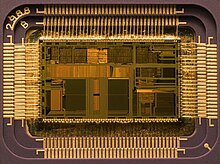Our website is made possible by displaying online advertisements to our visitors.
Please consider supporting us by disabling your ad blocker.
I486
 The exposed die of an Intel 486DX2 | |
| General information | |
|---|---|
| Launched | April 10, 1989[2] |
| Discontinued | September 28, 2007[1] |
| Designed by | Intel, with Pat Gelsinger as chief architect |
| Common manufacturer |
|
| Performance | |
| Max. CPU clock rate | 16 to 100 MHz[a] |
| FSB speeds | 16 MHz to 50 MHz |
| Data width | 32 bits[3] |
| Address width | 32 bits[3] |
| Virtual address width | 32 bits (linear); 46 bits (logical)[3] |
| Cache | |
| L1 cache | 8 KB to 16 KB |
| Architecture and classification | |
| Technology node | 1 μm to 600 nm |
| Instruction set | x86-16, IA-32 including x87 (except for "SX" models) |
| Physical specifications | |
| Transistors |
|
| Co-processor | Intel 80487SX |
| Package | |
| Socket | |
| History | |
| Predecessor | Intel 386 |
| Successor | Pentium/i586 (P5) |
| Support status | |
| Unsupported | |
The Intel 486, officially named i486 and also known as 80486, is a microprocessor introduced in 1989. It is a higher-performance follow-up to the Intel 386. It represents the fourth generation of binary compatible CPUs following the 8086 of 1978, the Intel 80286 of 1982, and 1985's i386.
It was the first tightly-pipelined[c] x86 design as well as the first x86 chip to include more than one million transistors. It offered a large on-chip cache and an integrated floating-point unit. When it was announced, the initial performance was originally published between 15 and 20 VAX MIPS, between 37,000 and 49,000 dhrystones per second, and between 6.1 and 8.2 double-precision megawhetstones per second for both 25 and 33 MHz version.[2] A typical 50 MHz i486 executes 41 million instructions per second Dhrystone MIPS and SPEC integer rating of 27.9.[4] It is approximately twice as fast as the i386 or i286 per clock cycle. The i486's improved performance is thanks to its five-stage pipeline with all stages bound to a single cycle. The enhanced FPU unit on the chip was significantly faster than the i387 FPU per cycle. The i387 FPU was a separate, optional math coprocessor installed in a motherboard socket alongside the i386.[5]
The i486 was succeeded by the original Pentium. Orders were discontinued for the i486 on March 30, 2007 and the last shipments were on September 28, 2007.[1]
- ^ a b "Product Change Notification" (PDF). Intel. May 2, 2006. p. 2. Archived from the original (PDF) on October 9, 2006.
- ^ a b c Lewnes, Ann, "The Intel386 Architecture Here to Stay", Intel Corporation, Microcomputer Solutions, July/August 1989, page 2.
- ^ a b c Intel (July 1997). Embedded Intel486 Processor Hardware Reference Manual (273025-001).
- ^ Chen, Allan, "The 50-MHz Intel486 Microprocessor", Intel Corporation, Microcomputer Solutions, September/October 1991, page 2.
- ^ LotusChain (January 28, 2024). "FPU in CPU". LotusChain Medium. Retrieved September 15, 2024.
Cite error: There are <ref group=lower-alpha> tags or {{efn}} templates on this page, but the references will not show without a {{reflist|group=lower-alpha}} template or {{notelist}} template (see the help page).
Previous Page Next Page


